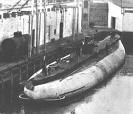|
Deutschland, German merchant submarine
 Deutschland was a blockade-breaking German merchant submarine used during World War I. It was developed with private funds and operated by the North German Lloyd Line. She was one of the first of seven U- 151 class, U-boats built and one of only two used as unarmed cargo submarines. Deutschland was a blockade-breaking German merchant submarine used during World War I. It was developed with private funds and operated by the North German Lloyd Line. She was one of the first of seven U- 151 class, U-boats built and one of only two used as unarmed cargo submarines.
Construction
Deutschland was built together with her sister ship Bremen in 1916 by the Deutsche Ozean-Reederei, a private shipping company created for the enterprise, a subsidiary company of the North German Lloyd shipping company (now Hapag- Lloyd) and the Deutsche Bank. She was constructed without armaments, with a wide beam to provide space for cargo. The cargo capacity was 700 tons, relatively small compared to surface ships.
Deutschland was one of seven submarines designed to carry cargo between the United States and Germany in 1916, through the naval blockade of the Entente Powers. Mainly enforced by Great Britain`s Royal Navy, the blockade had led to great difficulties for German companies in acquiring raw materials which could not be found in quantity within the German sphere of influence, and thus substantially hindered the German war effort.
Five of the submarine freighters were converted into long-range cruiser U-boats (U-kreuzers) equipped with two 105mm deck guns, and only two were completed according to the original design: the Deutschland and the Bremen, which was lost without a trace on her maiden voyage.
Merchant service
Deutschland departed on her first voyage to the US on June 23, 1916 commanded by Paul König, formerly of the North German Lloyd company. She carried 750 tons of cargo in total. Passing undetected through the English Channel she arrived in Baltimore on July 9, 1916 after just over two weeks at sea.
The Deutschland made another round trip in November 1916 to New London, Connecticut. On 16 November as she was trying to put to sea, the Deutschland rammed and sank the tugboat T.A. Scott, Jr., with the loss of five men aboard the tug. Her bows were damaged, and she had to return to New London for repairs, which delayed her departure by a week. She finally left New London on November 21, 1916.
War service
A third voyage, planned for January 1917, was aborted as German-US relations had worsened following the sinking of shipping bound for the United Kingdom, often just outside of US territorial waters. The Deutschland was taken over by the German Imperial Navy on 19 February 1917 and converted into the U-155, part of the U-Kreuzer Flotilla, being fitted with 6 bow torpedo tubes with 18 torpedoes, and 2 150mm deck guns.
She made three successful war cruises, sinking 42 ships and damaging one.
Final faith
U-155 returned to Germany from her final cruise on November 12, 1918 and was surrendered on November 24, 1918 with other submarines as part of the terms of the Armistice. She was taken to Britain and exhibited in London and was eventually sold for scrap in 1921. On September 17, 1921 she was being broken up at Robert Smith and Sons, Birkenhead, when an explosion ripped the ship apart, killing five apprentices.
Specifications, U-155, type U-151\ U- Cruisers:
Originally designed as a submarine freighters, for which they were built to mercantile standards, managed by a commercial company and manned by civilian crews. They mounted no armament and could carry some 740 tons of cargo.
Displacement (srf/sub tons): 1512/1875
Dimensions (L*B*D meter): 65.0*8.9*5.3
Propulsion: 2*800hp Germania 6 cylinder diesel engines, 2*800hp electric motors for submergence, driving two shafts
Speed (srf/sub knots): 12.4/5.2
Range (srf/sub n/miles@knots): 25,000@5.5/65@3
Diving depth (meter/feet): 50/164
Complement: 56 officers and enlisted
Torpedo: 6*19.7” (500 mm’) bow torpedo tubes, remainder of class had only 2 TT, total of 18 torpedoes
Mines: none
Armament: 2*150mm main deck guns, 2*88mm guns
Back to History Index
|